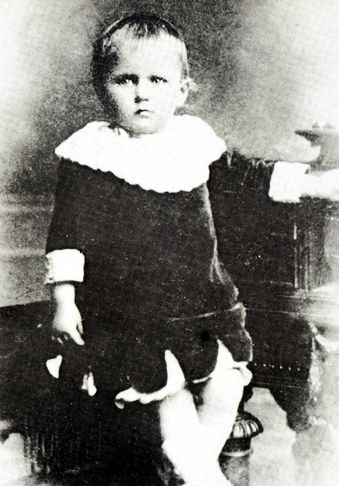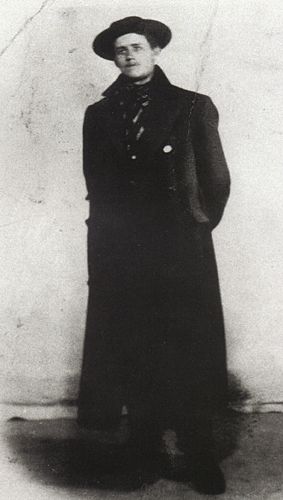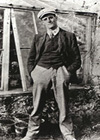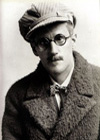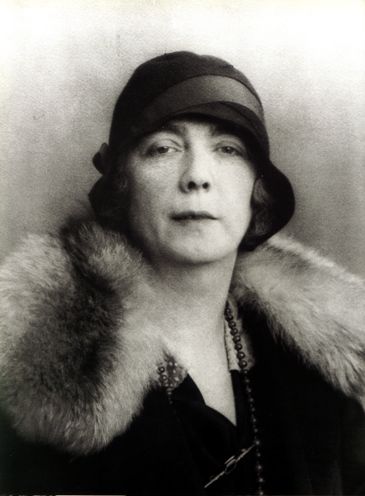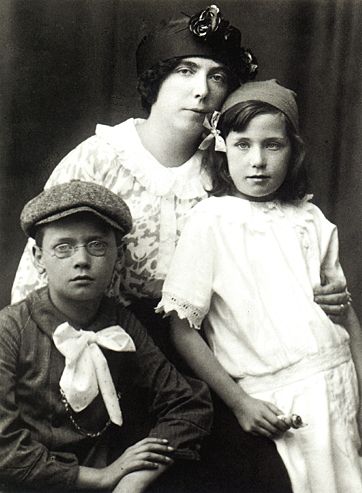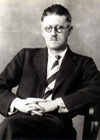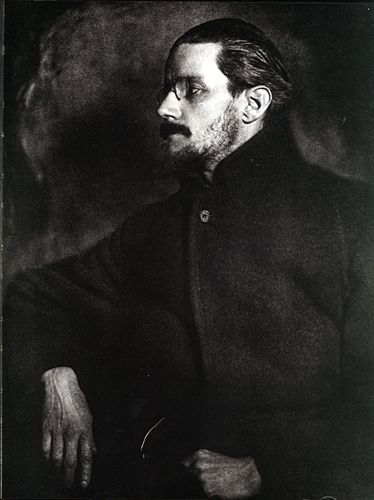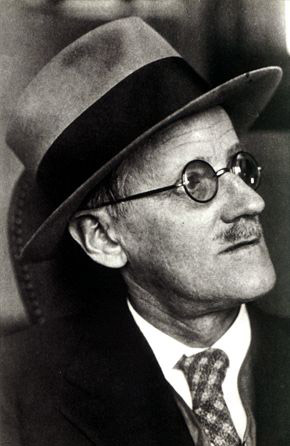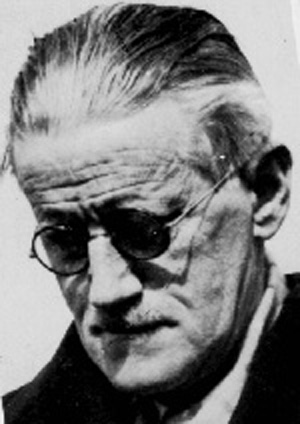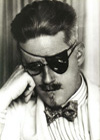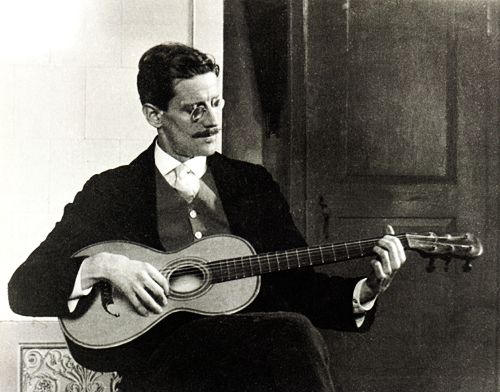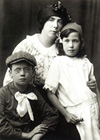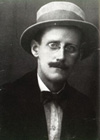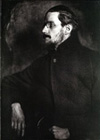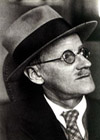
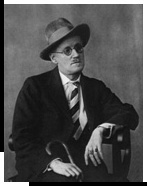
JAMES JOYCE
1882 - 1941
Photograph by Berenice Abbott
(1929)
“Oftwhile balbulous,
mithre ahead,
with goodly trowel
in grasp and ivoroiled
overalls which he
habitacularly fondseed...”
— FINNEGANS WAKE
IRELAND'S most famous writer
DUBLIN
Born James Augustine Aloysius Joyce on 02 February, 1882 in Dublin, Ireland. Joyce came from a large family. He was the eldest of ten children born to John Stanislaus Joyce and his wife Marry Murray Joyce. His father, while a talented singer (he reportedly had one of the finest tenor voices in all of Ireland), didn't provide a stable a household. He liked to drink and his lack of attention to the family finances meant the Joyces never had a great deal of money.
From an early age, James Joyce showed not only exceeding intelligence, but also a gift for writing and a passion for literature. He taught himself Norwegian so he could read Henrik Ibsen's plays in the original language, and spent his free time devouring the works of Dante, Aristotle, and Thomas Aquinas.
Because of his intelligence, Joyce's family pushed him to get an education. Largely educated by Jesuits, Joyce attended the Irish schools of Clongowes Wood College and later Belvedere College before finally attending the University College - Dublin, where he earned a Bachelor of Arts degree with a focus on modern languages.
Joyce's relationship with his native country was a complex one and after graduating, he left Ireland for a new life in Paris where he hoped to study medicine. He returned, however, not long after upon learning that his mother had become sick. She died in 1903.
Joyce stayed in Ireland for a short time, long enough to meet Nora Barnacle, a hotel chambermaid who hailed from Galway and later became his wife. Around this time, Joyce also had his first short story published in the Irish Homestead magazine. The publication picked up two more Joyce works, but this start of a literary career was not enough to keep him in Ireland and in late 1904 he and Barnacle moved first to what is now the Croatian city of Pula before settling in the Italian seaport city of Trieste.
TRIESTE, et al.
In Trieste, Joyce taught English and learned Italian, one of 17 languages he could speak, a list that included Arabic, Sanskrit, and Greek. Other moves followed, as the Joyce and Barnacle (the two weren't formally married until some three decades after they met) made their home in cities like Rome and Paris. To keep his family above water, Joyce continued to find work as a teacher. James ans Nora Joyce had two children, Georgio and Lucia.
All the while, though, Joyce continued to write and in 1914 he published his first book, Dubliners, a collection of 15 short stories. Two years later, Joyce put out a second book, the novel Portrait of the Artist as a Young Man which ws a reworking of an earlier unpublished (in Joyce's lifetime) book entitled, Stephen Hero.
While not a huge commercial success, the novel caught the attention of the American poet, Ezra Pound, who praised Joyce for his unconventional style and voice. During World War I, Joyce had moved his family to Zurich, where they subsisted primarily on the generosity of English magazine editor, Harriet Weaver, and Barnacle's uncle.
PARIS
The same year that the Dubliners came out, Joyce embarked on what would prove to be his landmark novel: Ulysses. The story in this masterwork recounts the goings on in a single day in Dublin. The date: 16 June, 1904, was the same day that Joyce and Barnacle met. On the surface, the novel follows the story three central characters, Stephen Dedalus, Leopold Bloom, a Jewish advertising canvasser, and his wife Molly Bloom, as well as, the city life that unfolds around them. But Ulysses is also a modern retelling of Homer's Odyssey, with the three main characters serving as modern versions of Telemachus, Ulysses, and Penelope.
With its advanced use of interior monologue, the novel not only brought the reader deep into Stephen Bloom's sometimes lurid mind, but pioneered Joyce's use of stream-of-consciousnesses as a literary technique and set the course for a whole new kind of novel. Ulysses is not an easy read, and upon its publication in Paris in 1922 by Sylvia Beach, an American expat who owned a bookstore in the city, the book drew both praise and sharp criticism.
This only helped bolster the novel's sales. Not that it really needed the help. Long before Ulysses ever came out, debate raged over the content of the novel. Parts of the story had appeared in English and American publications and in the US and the UK the book was banned for several years after it was published in France. In the US, Ulysses's supposed obscenity prompted the Post Office to confiscate issues of the magazine that had published Joyce's work. Fines were levied against the editors, and a censorship battle was waged that only further hyped the novel.
Still, the book found its way into the hands of eager American and British readers, who managed to get hold of bootlegged copies of the novel. In the United States, the ban came to a head in 1932 when in New York City Customs Agents seized copies of the book that had been sent to Random House, which wanted to publish the book.
The case made its way to court where in 1934, Judge John M. Woolsey came down in favor of the publishing company by declaring that Ulysses was not pornographic. American readers were free to read the book. In 1936, British fans of Joyce were allowed to do the same.
While he sometimes resented the attention Ulysses brought him, Joyce saw his days as a struggling writer come to an end with the book's publication and eventually Joyce and his family settled into a new life in Paris.
Success, however, couldn't protect Joyce from health issues. His most problematic condition concerned his eyes. He suffered from a constant stream of ocular illnesses, went through a host of surgeries, and for a number of years was near blind. At times Joyce was forced to write in red crayon on sheets of large paper.
In 1939, Joyce published Finnegans Wake, his long awaited follow-up novel, which, with its myriad of puns and new words, proved to be an even more difficult read than his previous work. Still, the book was an immediate success, earning "book of the week" honors in the US and the United Kingdom not long after debuting.
ZURICH
A year after Finnegans Wake's publication, Joyce and his family were on the move again, this time to southern France in advance of the coming Nazi invasion of Paris. Eventually the family ended back in Zurich.
Joyce had first traveled to Zurich with Nora Barnacle, then not yet his wife, in 1904, believing he was to start teaching English at the Berlitz School there. It was all a misunderstanding, but he did land a Berlitz job in Trieste. His and Nora's two children were born in the Adriatic seaport city, then still belonging to Austria-Hungary. After Italy entered World War I in 1915, the Joyces moved to Zurich. In the 1920's and 1930's the family lived in Paris, but the author every now and then revisited Zurich for treatment and surgery to save his failing eyesight. After the Nazi occupation of France, Joyce, with great difficulty, again obtained asylum in Switzerland for himself and his family.
In Zurich, the Joyce family stayed only briefly at the same place. They had four different apartments in the Seefeld district on the eastern lakeshore: 7 Reinhardstrasse; 19 Kreuzstrasse; 54 Seefeldstrasse, and 73 Seefeldstrasse. The Joyces also lived near Zurich University, at 29 and 38 Universitats-Strasse.
Following an intestinal operation, the writer died at the age of 59 on 13 January, 1941 at the Schwesternhause von Roten Kreuz Hospital and sadly never saw the conclusion of World War II. His wife and son were at his bedside when he passed. He is buried in Fluntern cemetery in Zurich.
Nora Joyce, who stayed on in Zurich after her husband's death, died in 1951. Giorgio Joyce, who grew up in Trieste, was present when the sculpture at his parents' grave was dedicated; he lived in Zurich and Munich, pursued a singing career, and died in Constance in 1976. (Joyce's daughter, Lucia, who had for many years been suffering from psychic disorders, died in an institution in Northampton, England, in 1982.)
LEGACY
DEVOTEES of James Joyce have long made pilgrimages to the cemetery on a hill overlooking Zurich and its lake where the writer, his wife Nora and their son Giorgio are buried. Fifty years after the Irish writer's death in 1941, the Swiss metropolis in which he found a refuge during the two World Wars will be visited by Joyceans from all over the globe.
They will linger at the graveside, look at autographs, pictures and other memorabilia in the new headquarters of the Zurich James Joyce Foundation, and maybe tour places familiar to the Joyces. Some fans from abroad, and quite a few Zurichers who may or may not care for pioneer literature, will on any day be found in a downtown pub whose Joycean furnishings have been shipped from Dublin to Zurich.
It was on Bloomsday (from Ulysses, Thursday, June 16, 1904) in 1966 that the statue marking the grave of the Joyces, amid birch trees, was unveiled in the Fluntern Cemetery. The life-size bronze by the American sculptor Milton Hebald represents the writer in his mature years, eyeglasses and all, seated on a square stone with his legs crossed, an open book in his right hand.
The Zurich James Joyce Foundation and archive has moved into the Strauhof at 9 Augustinerstrasse, a sloping lane in the old city. The first and second floors of the 430-year-old city-owned Strauhof building, which was recently restored, are used for temporary cultural exhibitions. The entire top floor is permanently devoted to the Irish writer. The archive, with four workrooms, is open 2 to 6 P.M., Tuesday, Wednesday and Thursday; outside these hours visits can be arranged on request by telephone from Monday to Friday. Admission is free.
A library of more than 3,000 volumes that can be consulted includes all works by Joyce in various editions and in translations into 30-odd languages. There are also many autographs; original or facsimile drafts and revisions by the writer; source material used by him; a wealth of literature about Joyce and his books; portraits and caricatures of him, and an original death mask. Joyce's own voice may be heard in a recorded reading of excerpts from Finnegans Wake.
The nucleus of the archive was assembled by Fritz Senn, a 62-year-old scholar and collector from Basel. Mr. Senn was appointed director of the expanded archive when the Zurich James Joyce Foundation was set up in 1985 with financial support from the Union Bank of Switzerland. Mr. Senn has received honorary doctorates from Zurich and Cologne universities, and has lectured at various American institutions of higher learning, most recently at Yale. He is in constant touch with the James Joyce Foundation in Dublin, and with Joyceans in the United States, who have an outpost in New York at the Gotham Bookmart, 41 West 47th Street...as the collection's director, Mr. Senn, observes, "Joyce is addictive."
